Swami Ramanananda Saraswati
(Sri T.N.Venkataraman)
At 8:30 p.m. on December 26th, Swami Ramanananda Saraswati, former president of Sri Ramanasramam (Sri T.N.Venkataraman), was quietly absorbed in Sri Bhagavan. The previous day he had fully participated in Sri Ramana's 128th Jayanti celebration in the Ashram and showed no signs of failing health until shortly before his passing on the following day.
Swami Ramanananda was an enthusiastic Assistant Manager of the Ashram from 1938 to 1950, while Bhagavan occupied his majestic form, and afterwards became Manager and President of the Ashram until 1994 when he took sannyasa and gave over the managing of the Ashram to his eldest son, Sri V.S.Ramanan. He knew full well that Bhagavan was with him throughout, guiding and protecting him in all ways. Swamiji occupied a special place not only in the Ashram but also in the hearts of all devotees whom he befriended and rendered service. His life story, recounted below, clearly demonstrates how he was the essential link to the perpetuation and dissemination of the grace and teachings of the Master, now revered the world over.
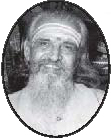
The birth of Sri T.N.Venkataraman, on May 26, 1914, carried more than ordinary significance to the family of Sri Bhagavan, since this event saved it from extinction. Sri Bhagavan's elder brother (Sri Nagaswami Iyer) was dead by then and the sister (Alamelu), though married, had no children. The younger brother, Sri Nagasundaram Iyer (whose sannyasa name was Sri Niranjanananda Swami) had lost two children. The sole hope of continuing the line lay in the birth of a child to him again. The mother, Alagammal, was greatly distressed and came to her Swami son at Arunachala, accompanied by Mangalam, Nagasundaram Iyer's wife, and sought Sri Bhagavan's blessing for a son. That Mangalam was thus blessed is evident from the following entry in the diary of Sri K.Natesan (then Supervisor, Corporation of Madras) under the date 30-11-1947 "Child Mangalam (Venkatoo's third daughter, a year old) prostrated herself before Sri Bhagavan after loudly addressing Him as Thatha (grandfather). Sri Bhagavan remarked: "Her grandmother was named Mangalam too". I asked Sri Bhagavan whether she had ever come to see Him. Sri Bhagavan replied: "O yes! She came to the Virupaksha Cave along with Mother. They stayed for the night there, which was unusual. This was the first occasion when women were permitted to do so. She returned home, became pregnant and Venkatoo was born. When he was two, Mangalam died. Seeing his (Venkatoo's) child Mangalam, one remembers all this!

The family of Nelliappa Iyer, Sri Bhagavan's uncle (in whose house at ManamaduraiManamadurai Sri T.N.Venkataraman was born) supported the young child. The father, Nagasundaram Iyer, went to Arunachala where he took sannyasa under the name of Sri Niranjanananda Swami. The motherless child used to address Nelliappa Iyer's wife as Amma. After three years Sri Bhagavan's sister, Alamelu Ammal, known to Ashram devotees as Athai (aunt) and her husband, Sri Pitchu Iyer, took over the care of the child and brought him up with great affection. He, like Sri Bhagavan, was given the name of Venkataraman after Lord Venkateswara of Tirupati, the family deity. The shortened name Venkatoo, by which devotees addressed him, had come into vogue in childhood.
He was brought to Tiruvannamalai twice or thrice a year to see Sri Bhagavan, then living in Skandashram.
Women were not allowed to stay in the Ashram but Sri Bhagavan assured Athai that she could safely leave the child in His care. On such occasions He would Himself put him to sleep, wash him and clean his teeth in the morning!
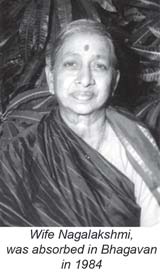
Sri T.N.Venkataraman went to school at Tiruppattur (Ramanathapuram) and ManamaduraiManamadurai . In 1929, he married Nagalakshmi, daughter of Sri Bhagavan's uncle, Sri Ramachandra Iyer. He was employed for a year in the Kunrakkudi Subramania Temple Devasthanam and then changed over to the Chettinad Bank where he continued till the end of January, 1938.
For his marriage the Ashram sent its blessings, together with new clothes and other gifts, through Sri Gopala Rao, the then Secretary of the Ashram. Sri Gopala Rao had much trouble in reaching Vetriyur, the venue of the wedding, since the village was inaccessible by rail or road!
The course of Venkatoo's life was changed in January, 1938 when he received a letter from the Ashram summoning him to Tiruvannamalai with his family and Athai and her husband. Before embarking on this change, Sri T.N.Venkataraman, now the father of two children, requested Sri Chellam lyer to go and find out whether the summons had the sanction of Sri Bhagavan. When approached by him, along with Sri Yogi Ramiah, Sri Bhagavan confirmed it. When someone said that Venkatoo had a family, He added: "What of that? Let him bring them too!" Thus it was with Sri Bhagavan's consent and blessings that Sri T.N.Venkataraman came to the Ashram for good.
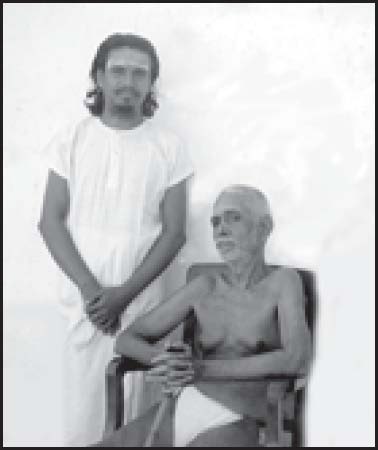
And so, from February 1, 1938, Sri T.N.Venkataraman worked in the Ashram office, assisting Sri Niranjanananda Swami, the Sarvadhikari (Sole Manager), whom he succeeded as President on January 30, 1953. On several occasions when the Sarvadhikari had to go away on Ashram business he was put in charge. Sri Bhagavan would some times refer people to him, saying: "Ask Venkatoo. He is the kutti (little) Sarvadhikari". More than once he said: "He is the future Sarvadhikari; take his view also".
Sri Niranjanananda Swami was apt to be brusque in manner towards Venkatoo. Since he was a sannyasin he was careful that none of the old relationship as father and son should continue between him and Venkatoo. He was very curt and would not allow Venkatoo even to join group photographs. Once it was Kavyakantha Ganapati Muni (group photo taken on 28-12-1928) and more than once it was Sri Bhagavan (group photo taken on 30-11-1947) who intervened and insisted on the inclusion of Venkatoo. Sri M.S.Kamath, a well-known devotee and the editor of Sunday Times, used to present on Jayanthi Day new khadi clothes to devotees and the Sarvadhikari would not permit any such gift being given to Venkatoo. A devotee (Sri Framji Dorabji's brother) had once presented a cycle to Venkatoo, but the Sarvadhikari claimed it for the Ashram! The Sarvadhikari did not permit him to move out of Tiruvannamalai and it was Sri Bhagavan who had to intervene and persuade Chinna Swami (Sarvadhikari) that Venkatoo was a householder and was free to move about as he pleased.
Sri Bhagavan had always shown love and kindness to Venkatoo. When Sri Seshadri Swami's body was interred, Sri Bhagavan asked Venkatoo to join Him and others in placing vibhuthi (sacred ash) on the samadhi pit. When large scale arrests were reported during the Quit India movement in 1942, Sri Bhagavan remarked that, if Venkatoo were not in the Ashram, he as a staunch Congressman would have gone to jail like his comrades! On August 15, 1947 – the day of Indian Independence – Sri T.N.Venkataraman brought the Revenue Divisional Officer and the Deputy Superintendent of Police of Tiruvannamalai to the Ashram and requested Sri Bhagavan to hoist the Indian National Flag in the Ashram. In fact, the previous night Sri Bhagavan Himself, along with other inmates, got the flag ready and helped arrange decorations. In memory of Sri Bhagavan's participation in this, the National Flag is hoisted at the Ashram every year on Independence Day.
When Gandhiji visited Madras in 1946, Venkatoo wanted to go and meet the Mahatma. Despite opposition from Chinna Swami, Venkatoo approached Sri Bhagavan, who gave not only consent but such encouragement that Venkatoo spent five days with the Mahatma in Madras and even secured his signature on the photograph of Sri Bhagavan. On his return he showed the photograph with Mahatma's signature to Sri Bhagavan who smilingly held it in His hands and also listened with interest to Venkatoo's detailed and enthusiastic report on his delightful participation in the Mahatma's day-to-day activities.
Once when Nan Yar? (The original Tamiḷ of Sri Bhagavan's Who Am I ?) had run out of print and new copies could not be printed for want of money, Sri Rama Satagopan, editor of Tyagi, wanted just enough money to buy the requisite paper and promised to do the printing gratis. Venkatoo, was the acting Sarvadhikari then and he immediately paid Rs. 100/- to Sri Satagopan. Mouna Swami (Srinivasa Rao) strongly objected. Sri Bhagavan who was coming along and heard all this, remarked "What? He is the Sarvadhikari, is he not? What is wrong with it?"
The administration of the Ashram had never been without problems. There were a few who had acted as secretaries of the Ashram till 1933. But these persons lived in the town and also had their office there, so that money and provisions had to be carried all the way to the Ashram daily. This was a cumbersome process. So at the request of many close devotees, Sri Bhagavan gave the general power of attorney to Sri Niranjanananda Swami, who became the Agent and Sarvadhikari. This was challenged by one, Perumal Swami, who had once been an attendant of Sri Bhagavan and now wanted to be the Sarvadhikari. In the legal proceedings that followed, Bhagavan had to depose before the Court, which, of course, sent a Commissioner to take the evidence. On the basis of Sri Bhagavan's deposition, the Court declared that the Ashram was Private Property.
To avoid similar troubles in future, devotees drew up a Will, under which the Ashram was to be maintained as a spiritual center and its management was to vest in the Sarvadhikari and, after him, Venkatoo and his descendants. Sri Bhagavan listened carefully as it was read out, made comments on it and approved of it. Where a blank space had been left, He told them to write in the names of Sri Niranjanananda Swami and Sri T.N.Venkatarama Iyer. He did not sign it, having no name to sign with, but He drew a line at the foot of it and allowed Sri G.Sambasiva Rao to declare that He had done so in token of approval. The document was registered on March 6, 1938 and attested by Dewan Bahadur K.Sundaram Chettiar, (Retd. High Court Judge, Madras), Sri M.M.Bhargava (Manager, Reserve Bank of India, Madras), Sri Yogi Ramiah, Dr.T.N.Krishnaswami, Sri T.S.Rajagopala Iyer and Sri R.Narayana Iyer (Sub Registrar, Omalur).
For the installation of the Sri Chakra Meru and the Kumbhabhishekam of Mother's Shrine -
Sri Mathrubhuteswara Temple - on behalf of Sri Bhagavan and the Ashram (Sri Niranjanananda Swami being a sannyasin could not do rituals), Sri Venkataraman officiated in all rituals.
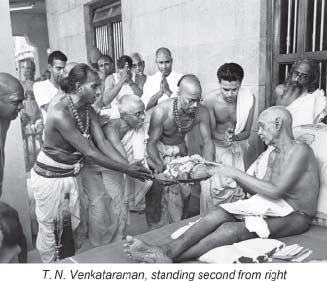 The vaidiks together with Venkatoo approached Sri Bhagavan and secured formal permission to commence the Kumbhabhishekam ceremonies. Again, when Sri Bhagavan attained Brahma Nirvana on April 14, 1950, the ceremonial acts of bathing, puja and burial on the following day were all performed by Venkatoo with scrupulous care and reverence.
The vaidiks together with Venkatoo approached Sri Bhagavan and secured formal permission to commence the Kumbhabhishekam ceremonies. Again, when Sri Bhagavan attained Brahma Nirvana on April 14, 1950, the ceremonial acts of bathing, puja and burial on the following day were all performed by Venkatoo with scrupulous care and reverence.
Sri T.N.Venkataraman played therefore an active role in both the ritual observances and practical administration of the Ashram. After the samadhi of Sri Niranjanananda Swami, he had to go to Court and obtain a certificate of succession to administer the Ashram (of course, with the aid of a Managing Committee). A case had been going on even from 1950, but finally in March 1954 the Court declared that Sri T.N.Venkataraman was entitled to manage the properties under the Will of the Maharshi. Again a case went up petitioning the Court to bring the Ashram under the Hindu Religious and Charitable Endowments Act, which would have meant that the Ashram was exclusively for Hindus. The Court declared the Ashram as a Public Religious Trust and recognized the position of Sri T.N.Venkataraman as the Hereditary Trustee, who was to manage the Ashram.
In spite of such preoccupations and administrative worries, Sri T.N.Venkataraman has always managed to keep cheerful. His dealings with devotees and Ashram inmates are characterized by warm affection and thoughtful concern. Hence he is sensitive to their requirements and difficulties and offers them the utmost help. The devotees, in their turn, hold him in loving esteem and regard him like a brother.
When he took over the management the Ashram was heavily in debt. Sri T.N.Venkataraman has retrieved it from this position and built up some capital and property, by the abundant grace of Sri Bhagavan and with the unstinted cooperation and earnest efforts of fellow devotees. Even a casual visitor to the Ashram can notice the substantial improvements effected, the number of new residential buildings, the facilities now available and the smoothness and efficiency of the whole administration. In fact, an experienced financier saw the accounts recently and remarked that it was a tremendous achievement to have built up the present reserve position! This is a tribute to the integrity, industry and managerial skill of Sri T.N.Venkataraman.
At home he was very simple. His children call him "ANNA" (elder brother). The family could not have a comfortable life till after the eldest son had got a job; but, in spite of the hardships, he had given all his children higher education. Likewise he has discharged in full his duty towards elders in the family. In the case of Manni (wife of Sri Nagaswami Iyer, Sri Bhagavan's elder brother, who passed away even before his wife reached her teens), Sri Bhagavan's wish, conveyed through Athai, was that she should stay. Manni consented and stayed. Athai and her husband, Sri S. Pitchu Iyer, also stayed with Venkatoo. He always cherished feelings of the greatest affection and respect for these elders and looked after their daily needs and comfort. He took the leading part in the 60th birthday celebration of Sri Pitchu Iyer, which went off in a grand manner in the presence of Sri Bhagavan. In their last moments, all these elders gratefully acknowledged that they had indeed been very well looked after by him. All his children married except Sri Ganesan, the second son, who was the Managing Editor of The Mountain Path and also assisted his father in running the Ashram.
With the blessings and presiding guidance of Sri Bhagavan, the gracious good wishes of elder devotees and willing cooperation from fellow workers, Venkatoo cheerfully carried on the management to the satisfaction of all concerned.
Understanding his limitations throughout his life, helped him to be submissive without being timid and flexible without being infirm. This remarkable quality enabled him to move on the best of terms with devotees and scholars, such as Major Chadwick, Sri Ramanananda Saraswati, Sri Devaraja Mudaliar, Mr.Arthur Osborne, Sri Muruganar, Sri Viswanatha Swami, Sri Kunju Swami, Sri T.P.Ramachandra Aiyeri and Sri Ramaswami Pillai. His achievements in completing Sri Bhagavan's Samadhi, its Kumbhabhishekam in 1967 and the opening of the vast Auditorium/Meditation Hall in front of it in 1970, and the renovation of Sri Mathrubhuteswara Temple (in 1967), will be cherished by posterity with gratitude. His untiring zeal in bringing out books on and by Sri Bhagavan is well known. Anxious to keep the Ashram as it was in the days of Sri Bhagavan, he has, despite odds, maintained the kitchen and the kind and quality of food that used to be served to the devotees. When once there was a suggestion that in view of rising costs the kitchen might be closed and a canteen opened outside the Ashram, he got furious and said: "I will never allow it to happen. For, I remember vividly how Sri Bhagavan was reading a newspaper article on Him and read aloud appreciatively the passage, "There are two fires in Ramanasramam: one is Sri Bhagavan Himself and the other is the kitchen fire. They both will never cease to kindle the heart of any devotee visiting the Ashram!. And so, I know how much Sri Bhagavan wanted the kitchen to be kept up and the devotees served good food".
Swami Ramanananda's Samadhi
You must know by now that Swamiji (Venkatoo) passed
 away on 26th December at 8:30 in the evening. He had attended Jayanthi the day before. Swamiji didn't come for Tamiḷ Parayanam that day. I lingered in the ashram after Parayanam and was standing outside Mother's shrine at 8:30 p.m. talking to some friends, so I was in the ashram when Swamiji got absorbed, but I didn't know it at the time. In the morning I went to the 4:30 puja and stayed for the chanting of
Vishnu Sahasranam. Then I went to Swamiji's room after taking prasad. They had propped him up on a table leaning against the window with an orange cloth around his jaw so to hold his head up. You wouldn't believe how peaceful it was. We were beholding a sannyasi in deep Samadhi. I thought he was still alive and in very deep meditation. I prostrated and sat for a while. Sushila and Sundaram were there with a few devotees. It was very intimate because it was early morning and still dark outside. One lady devotee began to chant the Vishnu Sahasranam. I left the room feeling somewhat sad, but that was soon swept away by the beauty and naturalness of the whole event. It happened just after Jayanthi, which he had attended. There was no suffering. He just went to the bathroom, vomited a little, lay down and then dropped the body. What a fitting end to someone who had dedicated his whole life to Sri Bhagavan and to the Ashram.
away on 26th December at 8:30 in the evening. He had attended Jayanthi the day before. Swamiji didn't come for Tamiḷ Parayanam that day. I lingered in the ashram after Parayanam and was standing outside Mother's shrine at 8:30 p.m. talking to some friends, so I was in the ashram when Swamiji got absorbed, but I didn't know it at the time. In the morning I went to the 4:30 puja and stayed for the chanting of
Vishnu Sahasranam. Then I went to Swamiji's room after taking prasad. They had propped him up on a table leaning against the window with an orange cloth around his jaw so to hold his head up. You wouldn't believe how peaceful it was. We were beholding a sannyasi in deep Samadhi. I thought he was still alive and in very deep meditation. I prostrated and sat for a while. Sushila and Sundaram were there with a few devotees. It was very intimate because it was early morning and still dark outside. One lady devotee began to chant the Vishnu Sahasranam. I left the room feeling somewhat sad, but that was soon swept away by the beauty and naturalness of the whole event. It happened just after Jayanthi, which he had attended. There was no suffering. He just went to the bathroom, vomited a little, lay down and then dropped the body. What a fitting end to someone who had dedicated his whole life to Sri Bhagavan and to the Ashram.
They buried him with the full rites of a sannyasi. They put Swamiji's body in the same place that they put Sri Bhagavan's picture at Deepam time. After Abhishekam they carried the body to the samadhi pit and the priests lowered it down. It was then filled with salt, vibhuti and earth. (There may have been something else too). They covered the pit sealed it with stones and put a small lingam that is now covered with flowers. His samadhi (tomb) is next to his father's samadhi, just below where they do the Sri Vidya Havan, in the area where they used to keep the potted plants. His body is facing the Hill. We all felt very fortunate because it was almost as if we were witnessing Sri Bhagavan's burial which I believe was done in a similar fashion. It was a beautiful ceremony and the priests will continue to do puja to the lingam now until the 9th January. There was of course sadness because Swamiji was the link between Bhagavan and the Ashram and also because he was a great physical presence here, but at the same time the atmosphere is so light because it was all so perfect.
Why is intellect developed? It has a purpose. The purpose is that it should show the way to realise the Self. It must be put to that use.
Kartigai Deepam at Arunachala
Deepam festivities were really incredible this year. Senthil, the Ashram's Veda Patasala head teacher, organized Gana Parayana in the morning during the ten days before the beacon is lit on top of the hill. He brought in ten pundits who were really incredible. There was also Sama Veda for one hour in the afternoon at the Ashram during the same period. Most evenings I went for darshan of the deities in the marriage mandapam at the Arunachala Temple and watched the priests decorating them and then doing Arathi. It was thrilling. Then I would wait inside the temple for the deities to come by in procession. A few times I stayed quite late (after midnight) to watch the men mount the deities on their special vehicles with great effort before they were taken into the street. There is such devotional fervor and everyone gets completely caught up in it. I saw many devotees from the Ashram running in front of the deities to get their darshan. Everyone seemed so happy. Despite the crowds I also managed to have darshan inside both Arunachaleswara shrine and Mother's shrine almost each time I went. Once I found myself inside the Arunachaleswara shrine surrounded by many police women. The priest did a puja for them. All the ladies were very happy and devoted.
The day after deepam in the afternoon, I made giripradakshina. When the light appeared on the hill I was feeling a little regret that I wasn't singing Arunachala Shiva at the Ashram and I started to sing the chorus because I don't know it by heart. Suddenly there appeared a bhajan group of Ramana devotees singing Ramana Sat Guru and I joined them for awhile. Then I lost them and ran into Sheila Arundale who was also doing pradakshina. We went to the temple together. Needless to say it was completely packed.
One of the police women from the other day was guarding the exit to the Arunachaleswara shrine and when she saw me she made a sign for us to go in. Sheila and I were really astonished. We never had expected to even be able to get through the inner gopuram let alone have darshan inside the shrines. The gates were closed and we had to go around the side in the dark. The same thing happened at Mother's shrine. One of the guards was warding us off, and suddenly one of the head priests appeared and told us to go in. So I feel very blessed and grateful to be there during that time.
Summer is of course much more 'meditative'. But these festivities are really special. When they light the beacon we are all sitting in front of Bhagavan's shine near his seat and picture, with our own beacon light opposite the holy hill. It is so very special. When we start to sing Arunachala Shiva as the flame appears my heart is ready to burst.
The crowds also seem to be more contained this year. I think the police are doing an excellent job and the rowdy elements don't seem to be around. It's very strong for everyone I've spoken to. It was nice seeing some devotees of Arunachala Ashrama this year.Marye Tonnaire
Sri Ramanasramam, India
Kartigai Deepam
Arunachala Ashrama, Nova Scotia
It was the Monday prior to Kartigai Deepam, when I arrived back at the Ashram after a morning of errands. I opened the entrance room door of the Ashram and my eye caught hold of something I had never seen before. It was the hurricane lamp we were going to bring up to the top of the Arunachala Ashram mountain on Saturday, the Kartigai Deepam Day. An Ashram devotee excitedly came into the room, telling me that this lamp was left in the barn by the previous owner and has been wrapped up in storage for decades. He said he had cleaned and oiled the metal surface and removed the thick layer of black soot that stained the glass. He then directed my attention to the engraved brand name on the metal surface below the shimmering glass. Sure enough, in big block letters it said "BEACON!"
I eagerly waited Deepam Day to make the one hour trek up the North Mountain of the Annapolis Valley. Saturday finally arrived. Following our morning prayers and meditation in the Ashram Temple, we lit a flame before the large photo of Arunachala and recited Aksharamanamalai. This was at 8:30 A.M., AST, which corresponded to 6 P.M. Indian time when the deepam is lit on the holy hill of the Beacon light. Later, at 3:00 P.M., on a day that temperatures hovered around 0 Celsius, a group of devotees visiting from the States joined us to take the journey up the mountain and light our 'Beacon' light to commemorate that most auspicious day when Lord Siva took the form of a column of light, revealing to the quarreling Brahma and Vishnu His greatness.
The five of us walked deep into the forest, slowly ascending the hill to our very own Skanda Ashram, which is a simple cabin, without electricity, nestled along side a narrow stream. There we lit incense and a Deepam at the altar of Bhagavan Sri Ramana Maharshi and continued up the mountain. We slowly made are way up the steepest incline, treading over the fallen leaves of maple, oak, beech and poplar trees, which reminded us of the impermanence of all life. After about forty minutes we arrived at a series of boulders, which we climbed over to reach Virupaksha Cave. This is a small cave that can comfortably seat about eight people. It is completely empty other than the mind-stilling and heart-opening first photo of the young Sri Ramana taken in 1901. After lighting candles and incense, making obeisance and chanting Arunachala Siva, we climbed out of the narrow cave entrance into the wide expanse of the northern sky, overlooking the Annapolis Valley, stretching to the east and west as far as the eye could see. Arunachala Bhakta Bhagavat, the Ashram founder, called it 'The Annapolis Valley of Peace and Happiness'.
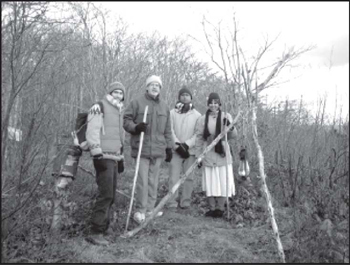
From the cave we continued our ascent. I had never been to this part of the mountain and we may have discovered another cave that the previous owner had told us about, but was never found. We had no time to explore, because this was not part of our mission and darkness was speedily approaching. While traversing these boulders enroute to the top, one of the pilgrims brought our attention to the Arunachala Hill of the youthful poet-saint Jnana Sambandar. He said that this North Mountain must have resembled the densely forested Arunachala of Jnana Sambandar's time, one thousand years ago. However, we don't have anything that resembles the freely roaming elephants he described in his hymns, but we do have the bears here in Nova Scotia. Finally, having arrived at the top, which is a designated look-off of the valley, we built a tripod of wood branches, lit the lamp and attached it to its stand. Now the curtain of darkness was falling and we had to get back down the mountain.
Descending by a different way, we carefully walked over the ruddy and at times muddy ground. Spontaneously we chanted "Arunachala Siva, Arunachala Siva, Arunachala Siva, Arunachala!" bringing us an ever greater peace of mind. It felt as if we were walking through a thick cloud of Silence. Upon arriving at the ashram we attended the Sri Chakra Puja in the Temple, a practice done every Friday and full moon. Deepam is always on the full moon day.
Although I have never been to a Kartigai Deepam celebration, or even to Arunachala, during this day Bhagavan revealed the greatness of Arunachala and His oneness with the Holy Hill of the Beacon Light. The same peace in the inmost cavity of the lotus of my heart, which I always have associated with Ramana, was present in the contemplation of Arunachala!
"To view Chidambaram, to be born in Tiruvarur, to die in Varanasi, or merely to think of Arunachala is to be assured of liberation."
Arunachala Ashrama
Nova Scotia Canada


